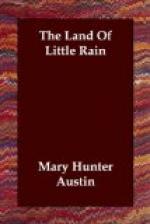First on the way to Jimville you cross a lonely open land, with a hint in the sky of things going on under the horizon, a palpitant, white, hot land where the wheels gird at the sand and the midday heaven shuts it in breathlessly like a tent. So in still weather; and when the wind blows there is occupation enough for the passengers, shifting seats to hold down the windward side of the wagging coach. This is a mere trifle. The Jimville stage is built for five passengers, but when you have seven, with four trunks, several parcels, three sacks of grain, the mail and express, you begin to understand that proverb about the road which has been reported to you. In time you learn to engage the high seat beside the driver, where you get good air and the best company. Beyond the desert rise the lava flats, scoriae strewn; sharp-cutting walls of narrow canons; league-wide, frozen puddles of black rock, intolerable and forbidding. Beyond the lava the mouths that spewed it out, ragged-lipped, ruined craters shouldering to the cloud-line, mostly of red earth, as red as a red heifer. These have some comforting of shrubs and grass. You get the very spirit of the meaning of that country when you see Little Pete feeding his sheep in the red, choked maw of an old vent,—a kind of silly pastoral gentleness that glazes over an elemental violence. Beyond the craters rise worn, auriferous hills of a quiet sort, tumbled together; a valley full of mists; whitish green scrub; and bright, small, panting lizards; then Jimville.
The town looks to have spilled out of Squaw Gulch, and that, in fact, is the sequence of its growth. It began around the Bully Boy and Theresa group of mines midway up Squaw Gulch, spreading down to the smelter at the mouth of the ravine. The freight wagons dumped their loads as near to the mill as the slope allowed, and Jimville grew in between. Above the Gulch begins a pine wood with sparsely grown thickets of lilac, azalea, and odorous blossoming shrubs.
Squaw Gulch is a very sharp, steep, ragged-walled ravine, and that part of Jimville which is built in it has only one street,—in summer paved with bone-white cobbles, in the wet months a frothy yellow flood. All between the ore dumps and solitary small cabins, pieced out with tin cans and packing cases, run footpaths drawing down to the Silver Dollar saloon. When Jimville was having the time of its life the Silver Dollar had those same coins let into the bar top for a border, but the proprietor pried them out when the glory departed. There are three hundred inhabitants in Jimville and four bars, though you are not to argue anything from that.
Hear now how Jimville came by its name. Jim Calkins discovered the Bully Boy, Jim Baker located the Theresa. When Jim Jenkins opened an eating-house in his tent he chalked up on the flap, “Best meals in Jimville, $1.00,” and the name stuck.




